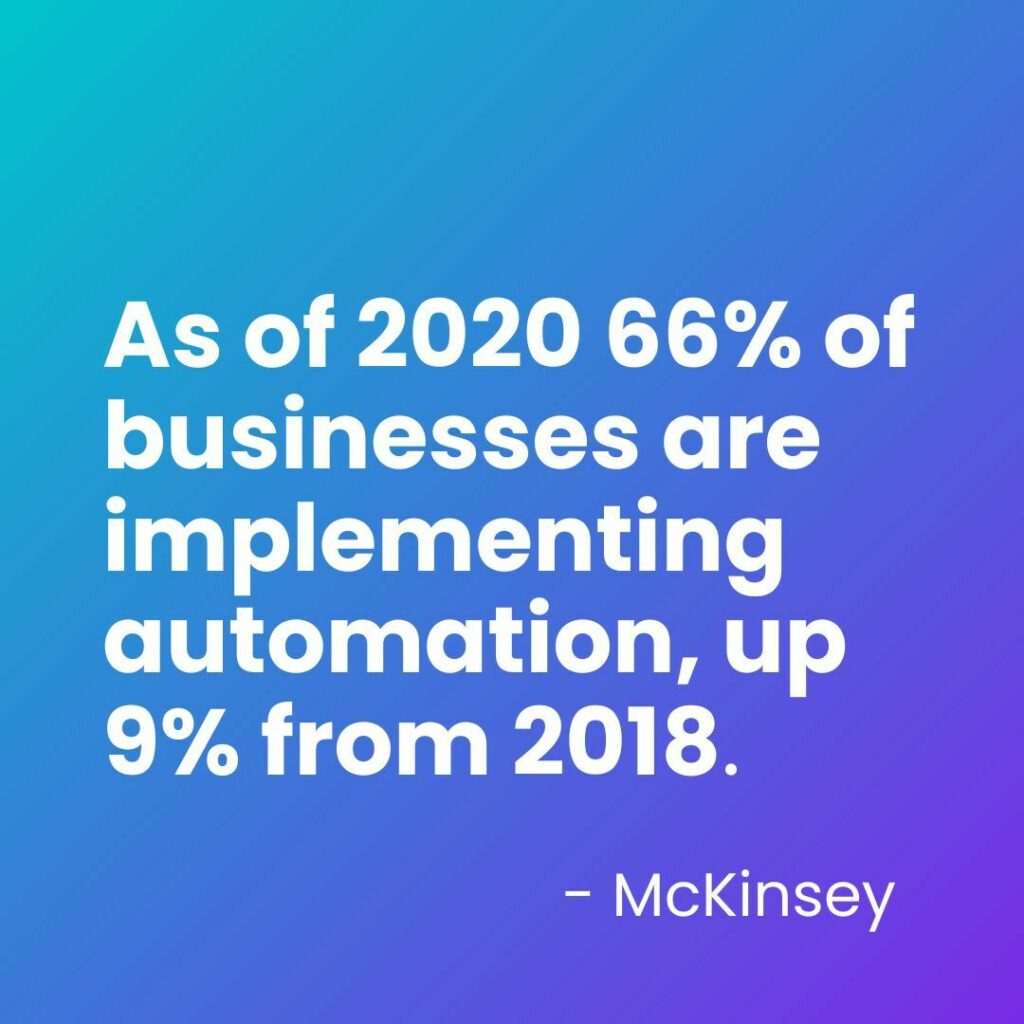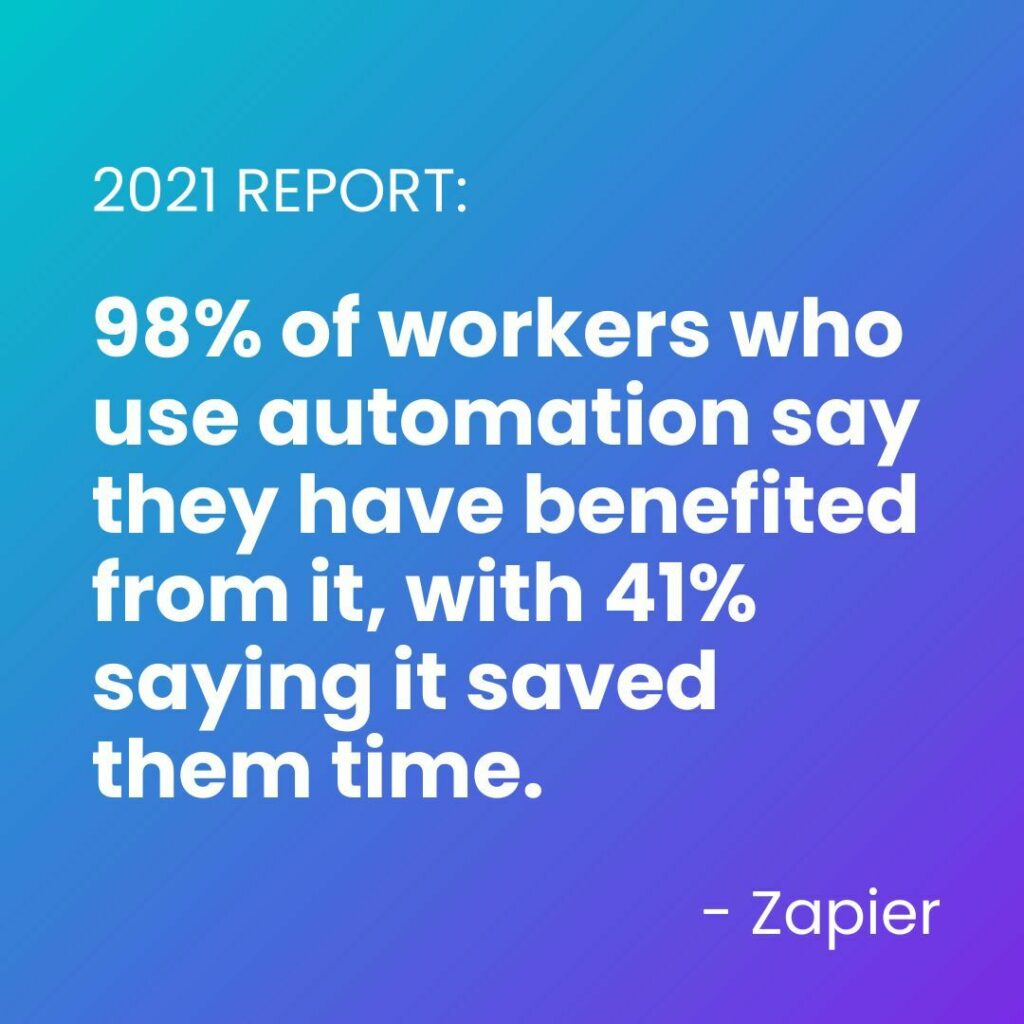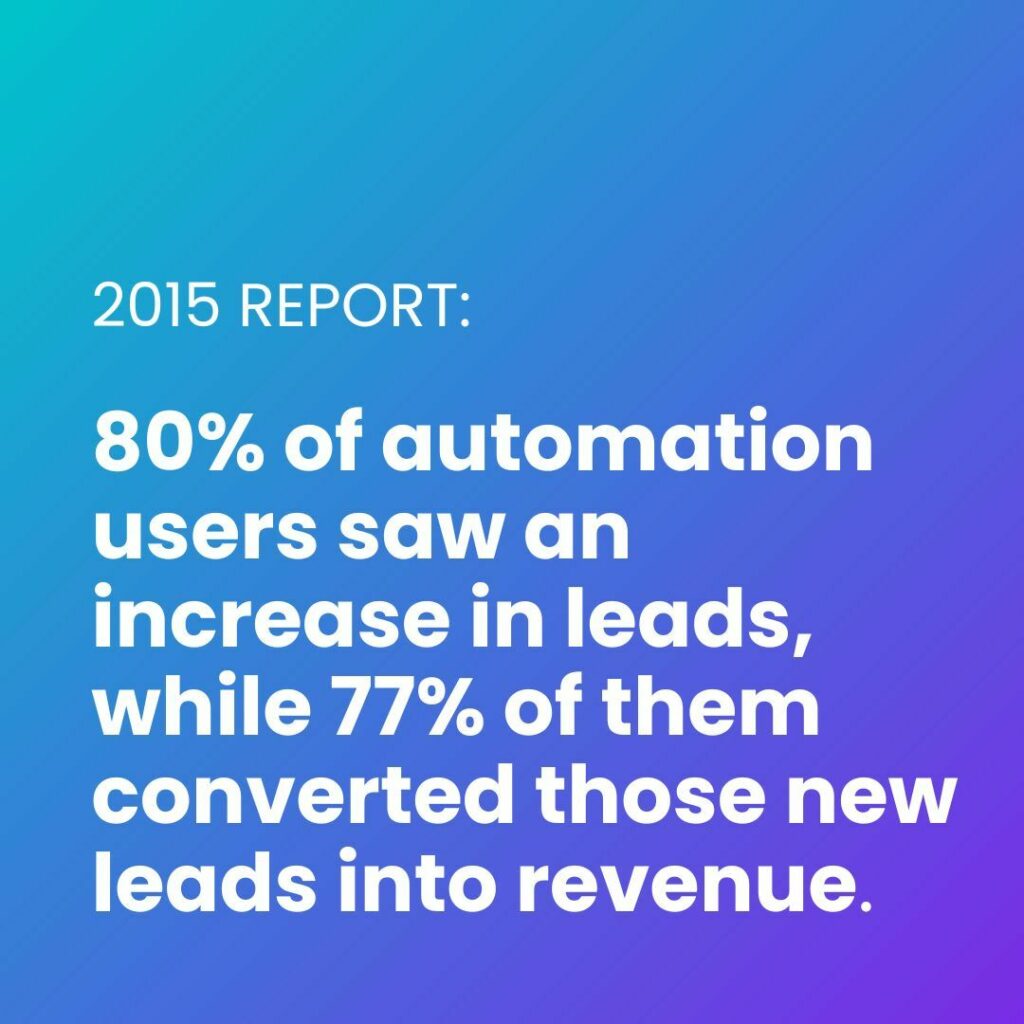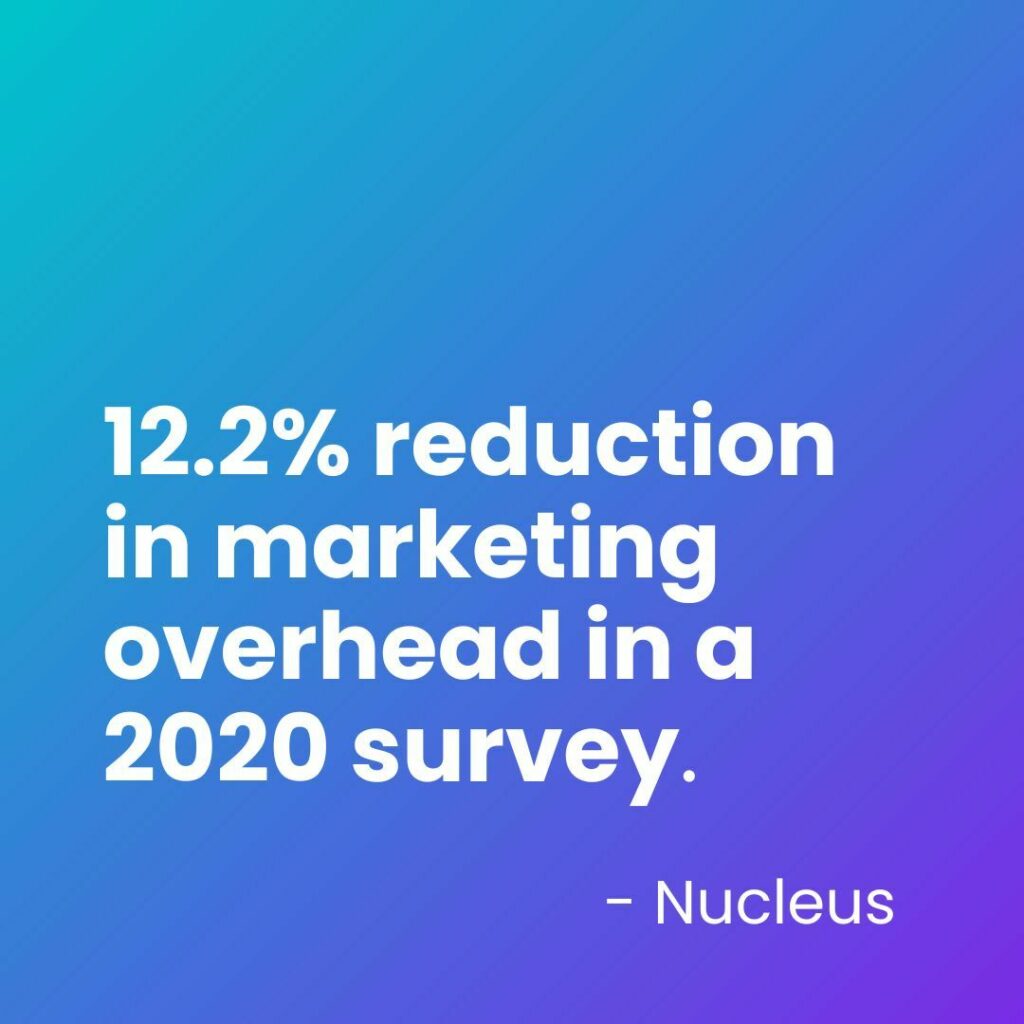Running your own service-based business takes a lot of time, energy, and brain power, all of which have limits. And when you’ve reached those limits, there are two choices: hire or automate.

A 2020 McKinsey survey found that 66% of businesses are implementing automation because it can be a game-changer, in terms of efficiency, time management, and reducing the risk of burnout. The number of businesses implementing automation is up 9% since 2018 and only expected it to rise.
Why is marketing automation important in a service-based business?

Marketing automation grants service-based business the opportunity to generate growth without overextending their workers’ time and energy. From setting up promotional emails to onboarding new employees, automation can significantly benefit small business marketing by streamlining processes, saving time, improving efficiency, and enhancing customer engagement. Reducing the workload by automating repetitive tasks, allows workers to channel that time and energy into more creative and productive pursuits to achieve growth goals as well as personal professional goals.
In a 2020 report from McKinsey & Company, “early adopters of sales automation consistently report increases in customer-facing time, higher customer satisfaction, efficiency improvements of 10 to 15 percent, and sales uplift potential of up to 10 percent.”
Benefits of automation service based businesses
Here’s how automation can help small business marketing:
- Time Efficiency: Automation tools can handle routine tasks like sending emails, scheduling social media posts, and managing customer data, freeing up your time for more strategic activities. In Zapier’s automation confidence index from 2021, 98% of workers who use automation say they have benefited from it, with 41% saying it saved them time.
- Consistency: Automating a process will ensure it is accomplished every time on time. Procrastination, weekends, and the time clock no longer prevent tasks from getting completed. Automation will help ensure client communications, emails, invoices/quotes, surveys, are delivered regularly and on time. Being consistent with all aspects of your communication with clients will help to maintain brand visibility.
- Increased Closed Rate: Automation can guide potential customers through the sales funnel by delivering relevant content based on their interactions with your website and emails. This personalized approach can increase the likelihood of converting leads into customers.
- Improved Decision Making: Marketing automation tools often provide detailed analytics, helping you track the performance of your campaigns. This data can guide your marketing strategy, allowing you to make informed decisions.
- Scalability: As your business grows, automation tools can help you manage an expanding customer base without requiring a proportional increase in manual efforts. In a 2015 VentureBeat Insights study, 80% of automation users saw an increase in leads, while 77% of them converted those new leads into revenue.
- Cost Savings: While there may be an initial investment in setting up automation systems, the time and manpower saved in the long run can result in significant cost savings. In fact businesses surveyed in a 2020 report by Nucleus found a 12.2% reduction in marketing overhead.
- Error Reduction: By automating manual, repetitive tasks, you reduce the risk of human error. With systems set up carefully and precisely, automation can handle tasks consistently, accurately, while providing real-time results for customers and workers alike.
The purpose of automation is to increase productivity and free up time to focus on other aspects of your business that need your attention. While the possibilities of automation are endless, like any technology, there will be some disadvantages. It’s up to you to determine whether these drawbacks outweigh the benefits for your business.
What are drawbacks to marketing automation?
- Loss of Human Touch: As fantastic as automation is, at the end of the day human beings are your customers, not machines. While using AI to generate your messages, it is important to keep an eye on your automated systems to make sure your messages don’t lose that human element. Without that personal touch, customers can grow frustrated and disengaged if they feel like they’re interacting with a machine rather than a brand.
- Data Quality Issues: Technology can only work as well as the information we provide it. Marketing automation relies heavily on accurate and up-to-date customer data. If the data is outdated, incomplete, or inaccurate, it can result in incorrect targeting and messaging, leading to customer frustration and wasted resources. Inaccurate information can also lead to improper segmentation and targeting can result in irrelevant messages being sent to the wrong audience, which can negatively impact the brand’s reputation. Do your due diligence and make sure you have the most accurate demographic information for your customers to avoid this pitfall.
- Learning Curve & Complex Implementation: New technology can be difficult for anyone to grasp. From understanding the basics to integrating it with current programs to ensure all your processes run smoothly and without interruption, training employees to use marketing automation tools and strategies can be time consuming. Adding automation tools can be as simple as using Zapier or as complicated as requiring custom built software. Some iterations of implementation require understanding how data is processed, when and in what format. It can be a daunting task that a consultant or expert can help you work through.
- Over-automation and Inflexibility: Marketing automation processes are predefined and rigid. Without careful monitoring, there’s a risk of over-automating marketing efforts, leading to an increase in the frequency of communications. The lack of flexibility and over communicating can lead to customers feeling overwhelmed, annoyed, or even marking messages as spam. It can also under timely responses and relevant interactions. Schedule check-ins for your automated process to make sure they are still serving their purpose and make the appropriate adjustments.
- Initial Investment and Ongoing Costs: Budgeting is a constant concern for any company, large or small. Marketing automations tools can often require an upfront investment as well as ongoing costs for maintenance, updates, and hiring specialized staff to manage the system. It’s important to check-in with your team to make sure automation continues to be the right fiscal decision for your business. Ultimately, however, automation is a long term investment with even longer term gains. Your company will save time, increase productivity and efficiency, and collect more leads,which will bring in more revenue.
How can my small business use marketing automation?
Your business can use marketing automation for growth activities, like lead generation and nurturing. Or Customer service activities that make your team’s job more streamlined like intake. And even administrative tasks like keeping your lists segmented and platforms connected via integrations. Let’s explore 9 ways your business can take advantage of marketing automation.

- Lead Generation: Find new customers without having to make cringe-worthy cold calls. By creating opt-in campaigns, using a targeted audience, you’ll be able to find people who actually want and need your service as opposed to angering potential customers by interrupting dinner.
- Audience Segmentation: Automation can automatically tag & categorize contacts in your CRM and marketing software based on activity, status, or other behavior, making it easier to communicate with subsets of your audience with more meaningful messages.
- Implement Email Marketing Automation: Email marketing platforms with automation allow for creating email sequences that are triggered based on customer actions. Emails would include welcome emails triggered by subscriptions, abandoned cart reminders triggered when customers don’t complete a purchase, post-purchase follow-ups when a customer doesn’t return within a certain window of time. In a 2018 Omnisend report, they found that sending a series of three automated emails resulted in “90% more orders for welcome emails, 63% more orders for cart recovery, and 75% more orders for customer reactivation.”
- Set Up Social Media Automation: Use social media management tools to plan a content calendar and schedule posts that includes a mix of promotional, educational, and engaging posts across various platforms. Monitor social media engagement and respond to comments and messages promptly.
- Automate Customer Service: Automation can lighten the load on your customer service staff by providing methods for customers to find answers without human intervention. Chatbots can provide instant responses to common customer queries or gather information prior to a human interaction and provide automated email responses for frequently asked questions or order confirmations.
- Integrate CRM and Sales Automation: Automation can increase sales outcomes through automated follow-ups, reminders, streamlining the sales process. Sales professionals estimate they save around 2 hours and 15 minutes daily using AI or automation tools to automate manual tasks such as data entry, note-taking, scheduling, and so on. Choosing a CRM system that integrates with your other automation tools will make this possible.
- E-commerce Automation: E-commerce is already a fairly human-less business model and automation can help increase efficiency in multiple areas including: marketing, fulfillment & customer service. With more people turning to online shopping to acquire their daily needs, upselling through confirmation or abandoned cart emails gives you an opportunity to share items they may not have considered while shopping. Allow automation to make fulfilling those orders easier, from storing inventory to processing orders to transporting them to their final destination.
- Referral Automaton: Give your customers the opportunity to refer new customers to you. Using your CRM, identify loyal customers as potential advocates, send referral requests with compelling incentives for them to tell their friends about your business. Use referral tracking to analyze which advocate was most successful and which points of contact were most effective.
- Stay Engaged: Staying connected to your customers is the best way to ensure repeat business. Acknowledging member anniversaries, sharing special deals, or even setting reminders for your sales team to keep leads warm can help them to feel like you value their interaction with your company. It will also help you to take a more proactive approach when more complex or unique situations arise.
Automation is not a one-size-fits-all solution. Use it to help boost efficiency and save time, but also tailor your approach to your business’s unique needs and goals, and be prepared to adjust your strategies as you learn more about what works best for your audience.
What should small businesses consider before automating processes?

Implementing automation is a major change for business processes. Aside from cost and how it will affect your workflow, you need to set your goals, find the right tools to help you achieve those goals, and create a plan for maintaining a personal connection with your customers. A clear plan of action will allow for a smooth transition as you embark on the path to creating a more efficient workplace for yourself and your employees and a better user experience for your customers.
- Understand Your Processes and Goals: Before making changes to how you do things, you must first have a good understanding of how and why you do them the way that you do. Identify redundancies, and tasks that are time-consuming and prone to errors. Once you’ve done that it will allow you to clearly define your automation goals and ensure that it’s the best fit for you.
- Choose the Right Automation Tool: Once you’ve laid out your goals, you will have an easier time selecting the automation tools that will work for you. Ease of use and integration will be at the forefront as you look for tools that will help your employees get familiar with new processes and allow you to better connect with your customers.
- Maintain a Personal Touch: While streamlining processes is great for business, you must remember that your customers are still human beings. They will want to connect with people to help solve their issues and that personal touch will help you stand out as everything becomes more computer generated.
How to expand automation programs
As your business evolves and your automated processes become established, it’s important to continually reassess and realign your priorities. Here are some additional automation ideas you can implement to expand on your existing programs:
- Regular Assessment: Set a schedule for reviewing your automated processes and their outcomes. This can be done quarterly, semi-annually, or annually, depending on your business’s pace.
- Data-Driven Insights: Analyze the data and metrics from your automated processes. Are they meeting their intended goals? Are there areas where automation is falling short? Use this data to guide your priority realignment.
- Customer Feedback: Listen to your customers. Their feedback can provide valuable insights into what’s working and what needs improvement. Prioritize adjustments that address their needs and concerns.
- Flexibility: Be open to adjusting your strategies. Sometimes, the initial plan might need modification based on new information or changing circumstances.
- Benchmarking: Compare your business’s performance to industry standards and your competitors. This can help you identify areas where your automation could be fine-tuned.
- Team Input: Involve your team in the realignment process. They’re on the frontlines of using these automated processes and can offer insights into their effectiveness and any bottlenecks.
- Scaling Up: If your business is growing, your automation priorities might shift toward handling increased demand. Ensure your automated systems can handle the expansion. Consider your long-term business goals. Your priority adjustments should align with these objectives and help propel your business toward its desired future state.
- Identify Opportunities: As your business needs grow, so will the space where automation can help fill in any gaps. From customer service to employee onboarding to legal and compliance matters.
How to choose marketing automation software
Choosing the right automation software is all about your business and what you are trying to accomplish with automation.
- Identify & Document the Process You’re Automating: Take an assessment of all your marketing processes and document how you currently execute them. Once you know what you want to do, it will be easier to narrow down the list of automation software to choose from.
- Research, Compare, and Review Options: Research is critical to picking the right tool that fits your needs, goals and budget. Read reviews and testimonials, consult online resources, and seek recommendations from peers or industry experts to gauge the software’s performance, reliability, and customer satisfaction. Take note of the features to ensure they will align with your automation needs and goals. Case studies or success stories from other businesses will showcase how they have benefited from the tool.
- Ease of Use and Integration Capabilities: Evaluating the platform’s ease of use will only help with your team’s adoption and implementation process. Choosing a platform with an intuitive and user-friendly interface. Also be sure that the software can integrate with your existing tools and systems, such as CRM, e-commerce platforms, and analytics tools. Integration ensures a seamless flow of data and processes across different software.
- Customization and Personalization: Personalization is key to today’s consumer. It makes them feel known to the companies where they choose to spend their hard earned dollars. Ensure the platform allows you to customize and personalize your automation efforts.
- Support and Training: Look for automation platforms that provide their customers with quality customer support like tutorials, guides, and a responsive support team. Training and onboarding options are important, especially if your team is new to marketing automation.
- Pricing Structure: Understand the pricing model of each software. Some tools charge based on the number of contacts, while others may have flat fees or tiered pricing. Consider both short-term and long-term costs, especially as your business grows.
- Security and Data Privacy: Ensure that the software complies with data protection regulations and offers strong security measures to protect your customer data.
Where else can automation have a big impact in a small business?
- Human Resources: Use automated applicant tracking systems to simplify and manage job postings, track candidate applications, screen resumes, and schedule interviews more efficiently. Easily store, access, and update employee information, such as personal details, performance evaluations, and training records. Automation can assist with compliance by tracking and managing HR-related documents, such as certifications, licenses, and training records, to ensure they are up to date and compliant with regulatory requirements. Automation can assist in tracking and rewarding employee achievements and milestones, contributing to higher engagement and job satisfaction. Collect employee feedback, helping HR professionals identify areas for improvement in the workplace. Automation should never fully replace human interaction.
- Onboarding & Offboarding: In a Harris Poll conducted on behalf of CareerBuilder and Silk Road, 29% of employees felt that their company’s onboarding process could have been done better. Let automation play a role in employee onboarding and engagement. Automated communication can help new employees become familiar with company culture, policies, and processes by generating offer letters, distributing employee handbooks, and collecting required documents electronically. It can also help with offboarding by deactivating accounts and collecting exit surveys.
- Sales Department: Sales reps can automate task assignments and reminders for follow-ups, appointments, and other important activities. This ensures that no leads or opportunities fall through the cracks. Some sales automation tools can automate the creation of sales proposals and quotes, saving time and ensuring consistency in the sales process. Optimize strategies and make data-driven decisions by using sales automation software to gather data and analytics on sales performance, lead conversion rates, and sales pipeline health.
- Customer Service: Customer service automation can lead to faster response times, reduced customer service costs, improved customer satisfaction, and more efficient use of support team resources. In a 2022 Calabrio report, 60% of consumers said they switched brands due to bad customer service. Use an automated ticketing system to log, categorize and track customer inquiries while finding the right agent to assign the task. Create knowledge bases and FAQs so customers can easily troubleshoot issues on their own.
- E-commerce and Online Transactions: Enhance the shopping experience for customers, improve operational efficiency, and increase sales. Use automation to create your online storefront, manage inventory, and streamline the refunds and returns process. You can also use automation to protect your customers. Fraud detection systems use algorithms and AI to identify potentially fraudulent transactions, reducing the risk of financial losses.
- Supply Chain and Inventory Management: In businesses with physical products, marketing automation can play a role in inventory by sending automated alerts when stock levels are low. This can help ensure a smoother supply chain and prevent stockouts.
- Payroll: Streamline payroll processing, including time tracking, tax calculations, and direct deposit. It can also assist in benefits enrollment and management, ensuring that employees receive the benefits they’re entitled to. Automated time and attendance systems record employee hours accurately, reducing errors associated with manual time tracking. They can also integrate with payroll systems for seamless processing. HR automation can handle leave requests, approvals, and tracking, ensuring compliance with company policies and labor laws.
- Office Supplies: Automating office supply ordering can lead to cost savings, improved supply chain management, reduced administrative overhead, and enhanced compliance with procurement policies. It also helps organizations maintain a well-organized and adequately stocked office environment, which contributes to overall productivity and employee satisfaction. Use it to maintain vendor information, track supplier performance, and evaluate vendor contracts. Keep track of data on office supply expenses, categorize costs, and provide insights into spending patterns. This helps organizations identify cost-saving opportunities, and set budgets and alerts when expenses approach or exceed budget limits.
- Accounting & Bookkeeping: Increase accuracy, reduce manual data entry, save time, and enhance the overall efficiency of financial operations. Capture financial data from various sources, such as invoices, receipts, and bank statements, and automatically populate accounting software, reducing the need for manual data entry. Manage employee and business expenses with systems that allow employees to submit expenses digitally, automatically categorize expenses, and route them for approval. Automated accounting systems can also generate standard financial reports, such as income statements, balance sheets, and cash flow statements, saving time on manual report creation. Budgeting and forecasting tools can analyze historical financial data and use predictive analytics to help organizations create accurate financial projections.
As automation becomes more popular, it’s hard to argue that the benefits don’t outweigh the drawbacks. Time saved on everyday tasks can now be used toward setting strategic goals for the continued success of your business. It allows you to raise the bar for success and put you on the competitive playing field with others in your industry. It is important, however, to strike a balance. Over-automation can lead to impersonal interactions and a loss of authenticity. A human touch is still essential, whether it’s addressing unique customer needs or handling complex issues or onboarding a new employee.
What areas of your business are you automating?

